Sundays are food planning and shopping day at house Swann. I enjoy this as I get to look at all sorts of pretty recipes, and think about the food I’ll be eating in a week’s time. But I know not everyone enjoys it like this, so here is how I do it, step by step. Hopefully it’ll give you some ideas too.
I’ll start off with saying that we’re only a household of two, but this can be applied to a single person or even bigger households. The thing is to stay sensible and to remember that food is important in your life and that planning out your food makes it less of a chore.
This post won’t be going into a lot of things related to food planning, this will just be how you can plan your meals more easily. Otherwise this post would be really really long and I’m afraid it’ll be long enough as it is… Things like why food planning is a good idea, how to plan your shopping trip and things like that will be covered in another post.
How I plan our meals per week
I plan only my lunch and our dinners. I usually have 1 recipe for lunch (5 days), and 3 meals for dinners (depending on the portion size/portion counts of the meals). I don’t plan breakfasts because I always have overnight oatmeal for breakfast and my boyfriend has muesli for breakfast and cheese-ham sandwiches for lunch. So those are standard.
This leaves me with my lunch and our dinners.
Our weeks consist of 6 home-cooked dinners and 1 takeaway or dinner out of the house. So we plan for 6 days and then sort of eye-ball the “off” day. Mostly this one will be on Friday, but sometimes Thursdays make more sense and sometimes Saturdays will be easier. We do whatever fits *us* best.
Tip:
If you’re only a small household, one or two people, get in the habit of making full-size recipes and then eating them muliple days. That way you keep the right portion size, it’s cheaper, you have less waste and it’s faster. You can either eat them in a row or freeze the portions and then switch them out with other meals.
Where do I plan from
I get most of our recipes from 2 different sources. The Hairy Dieters cookbooks and a local free magazine that one of our grocery stores releases every month, Aller Hande.
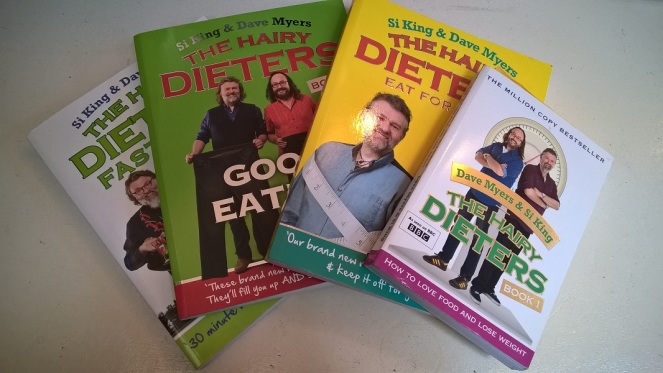
We have all four of The Hairy Dieters cookbooks and we’ve probably made about 80% of all the recipes in the first three and 1/3 of the recipes in the fourth book (it’s a new book, so we didn’t go through it yet). We learned a lot from making these recipes, things that we now also apply to other recipes.
These are British cookbooks, so some of the ingredients are harder to get in the Netherlands (like lamb mince, or lamb at all), or come in a different size here (when it states medium courgette, we need to get a small one). But those things are easy enough to overcome.
Tip:
We actually started at the beginning of The Hairy Dieters books and cooked every recipe that wasn’t a breakfast or sweets recipe (and skipped some recipes that had ingredients we don’t like, like couscous). This meant that we didn’t have to worry about searching for recipes for about 3 or so months, we just made the next recipe. And we ate recipes that we wouldn’t nessecarily choose normally, but that were still delicious.
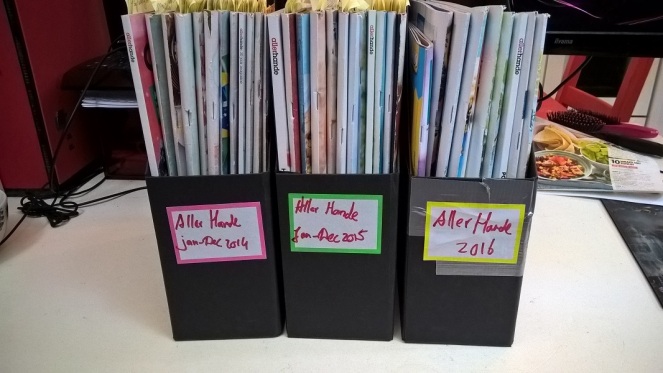
Many people from the Netherlands will recognise these magazines, the Aller Hande, as one of our local grocery stores releases them. They’re about 1/2 recipes and 1/2 ads, but some of the recipes in them are really awesome. The name of the magazine also shares its initials with the store that releases these magazines the Albert Heijn (both are often shortened to AH). The recipes are diverse, and often come with a theme (like pasta, or French or Italian food, things like that). As you can see, we often tag the recipes that we’re interested in and may want to cook (the 2016 editions don’t have them as I just folded over the corner of the page on those). These are of course all in Dutch, but I’d be curious if other countries have similar options available for them in one of their stores (some of our other stores also have magazines like this, also for free, but I prefer the recipes from the AH).
If you know some of these types of magazines in your country, please mention them in the comments so I can make a list to help others too. The important thing is that these are free, so they’re a good choice for shoppers of all budgets.
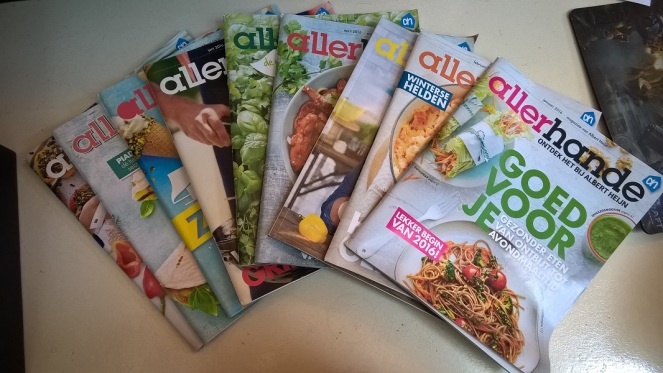
I love these two options for a couple of reasons: they all list calories with the recipes, they (usually) include only ingredients that you can easily pick up at the stores and they are varied. Between The Hairy Dieters and the Aller Hande, we have a whole range of foods to choose from and we don’t need to search all over the internet for recipes that we may or may not like.
How to plan
For this you need three things:
- your fav way of collecting recipes
- pen
- paper
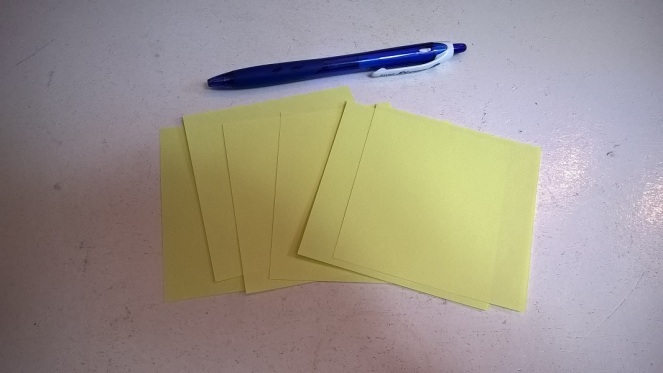
You’re going to need at least two different pieces of paper. One to write your recipes on and one to write your shopping list on. And this is to keep yourself on track, if you only write your shopping list down, you may actually forget the recipes you were supposed to make and then not follow your plan.
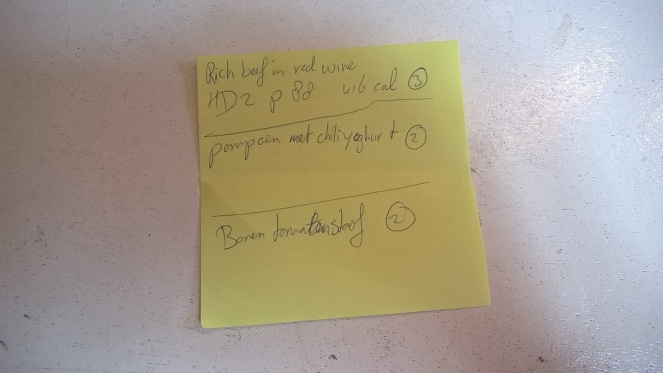
I usually write down the:
- Name of the recipe
- Where I got it (for example AH means Aller Hande and DH means Hairy Dieters) with page number
- Number of days we’ll eat it (calculated by servings/2, so a recipe with 4 servings is 2 days of dinners for us)
- Calories (this is important to us, but is totally optional)
We try to get at least 6 or 7 days worth of recipes. This is so that we can buy everything in one go without the fresh food going bad before we can use it (which is even more important in the summer months).
On Sunday, my boyfriend and I sit down and decide what we’ll eat the coming week, this often depends on:
- What we feel like eating (pasta, spinach, rice, stews)
- What is in seasons (like Brussel sprouts or pumpkin)
- What is on sale
- What type of week we’ve got coming up (for busy weeks we often choose faster recipes, under 15 minutes, and for calmer weeks we may choose some longer recipes, 30 minutes or more)
- The weather (who am I kidding, we’ll eat stews in the middle of summer and tortilla wraps recipes in the middle of winter)
Some weeks this will take almost an hour, but usually we’re done in under 15 minutes. Today it took us 15 minutes and that included writing down the ingredients.
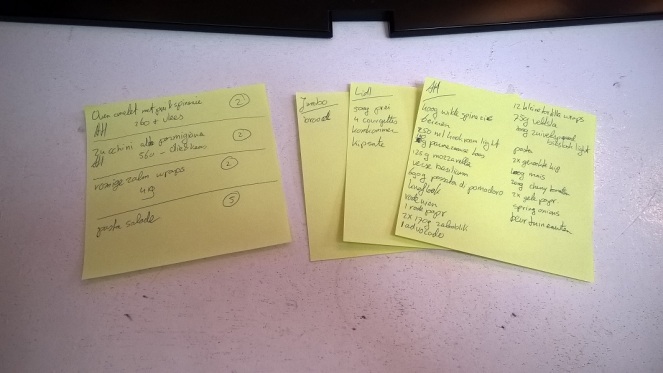
When I write down the ingredients I will also write down how much of each one we’ll need so I’m sure that we’ll get the right amount and the calories of the recipe will match the calories of the dinners we eat. This does not include things that you buy in bigger bags than you need but that will keep well longer (pasta, onions, garlic, spices, etc. cupboard stuff), those I will just write down without a number.
And Next…
And then you go shopping and you take your grocery list with you (of course, don’t forget to add all the other things you need to buy like drinks or breakfast items or other stuff, those weren’t on our lists because we weren’t running low on them yet).
We will on average do one weekly shop and two top-up shops for breakfast, lunch and snack items (these top-up shops usually consist of yogurt, milk, muesli, frozen fruits, bread and rolled oats). Our weekly shop in foods is about $80 in total (rough estimate), and we buy lots of both budget and more expensive food items.
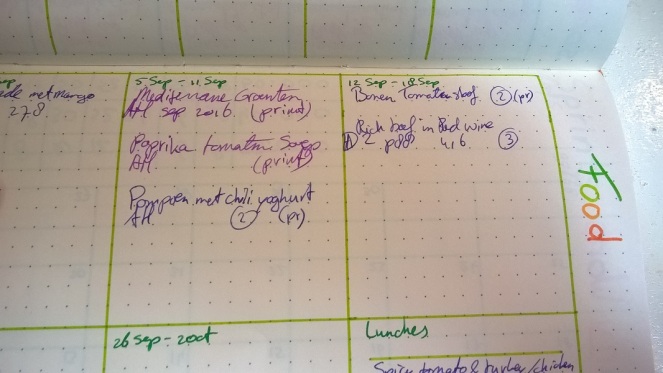
After the shop, during my weekly set-up, I will also write the recipes in my Bullet Journal on my monthly page (this used to be on my weekly page, but I no longer track my food in my Bullet Journal, so I moved it to my monthly overview). That way I’m not dependent on a small piece of paper, but instead have it somewhere where I know I’ll be able to find it. You can of course write it on a black- or whiteboard (we used to do this), stick the list of recipes on your fridge (good place to have them) or put them in another planner that you use. But make sure that you don’t lose your list and that you keep it in a place where you can find it.
Tip:
I also like to keep it in a central place as I can refer back to it when I’m lazy and can’t be bothered to look through all of the other recipes.
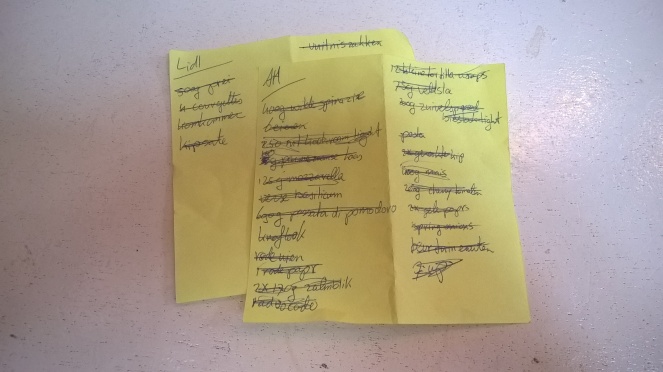
And this is what the shopping lists look like after we’re done. We cross out each item on the list so we won’t forget what we’ve already got in our cart.
That’s it! This is how we plan our weekly dinners (and lunches for me). If you have any question, comments or requests for future posts, please leave a comment below!

This is brilliant. I’m all about function and simplicity. I’d never thought of just repeating the same three recipes for the week–BRILLIANT! Thank you so much!
LikeLiked by 1 person
I’m glad you enjoyed the post! I started what I called “batch cooking” when I lived on my own at university. I’d cook once, and then could eat for more than a week. This helped me a lot over time. I still apply those same things now when I cook for two. Makes life just a little bit less hectic.
LikeLike
Thank you so much! This is simple and brilliant! I can’t wait for the follow up post on the different shopping lists. Again, thank you so much and thanks for posting in the Bullet Journal Junkies group!!!
LikeLiked by 1 person